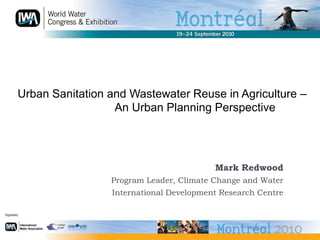Urban Sanitation, Wastewater And Climate Change
- 1. Urban Sanitation and Wastewater Reuse in Agriculture ŌĆō An Urban Planning Perspective Mark RedwoodProgram Leader, ClimateChange and WaterInternational Development Research Centre
- 2. Outline of PresentationIDRCDrivers of wastewater useIllustrations of wastewater use in citiesTheproblemwithurbanplanningWhat can be done?
- 3. IDRCCreated by Canadian Parliament in 1970
- 4. International Board of Governors
- 5. Research in developing countries to promote growth and development
- 6. IDRC workonwastewatergoes back to 1998
- 7. Partners in thisworkinclude at least 15 researchinstitutions
- 8. WHO, IWMI, FAO, World BankDrivers of Wastewater UseWater stress and climatechangeUrbanization, populationgrowth and foodinsecurityFailure of sanitation
- 9. Water stress isontheriseSources: Comprehensive Assessment of Water Management in Agriculture 2007; and UN Department of Economic and Social Affairs 2008
- 10. Source: IPCC, WG2, 2008Examples of freshwater stress associatedwithclimatechange
- 11. ŌĆ£Increasing water scarcity combined with increased food demand and/or water use for irrigation as a result of higher temperatures are likely to lead to enhanced water reuse. Areas with low sanitation coverage might be found to be practising (as a new activity or to a greater degree) uncontrolled water reuse (reuse that is performed using polluted water or even wastewater).ŌĆØSource: p. 70, WG 2, IPCC 2008
- 12. UrbanizationSource: UN Habitat 2008
- 13. Source: ProgressonDrinkingWater and Sanitation - WHO UNICEF 2008
- 16. Mark Redwood - PUREWastewaterPipe water
- 17. Mark Redwood - UPEButpeople can be at riskwhenconsumingproductsirrigatedwithuntreatedorpartiallytreatedwastewater. KAMPALA EDIBLE LANDSCAPE PROJECT
- 18. Source: World Bank 2010
- 19. PlanningFailuresTendency to aim for high-tech, high-cost ŌĆō ŌĆ£skipping steps in the sanitation ladderŌĆØOperation and maintenance ŌĆō the inability to recover costsPolitical stasisTraining for planners has its limitsŌĆ” there are conventions (and sometimes for good reason!)
- 20. Whatisrequiredtochangehowwe plan and managewastewaterforreuse?
- 21. FiveStepsThat Can Make a DifferenceRemindourselves of the ecological basis of planningŌĆ£ReverseŌĆØ thewaterchainwhenwe plan and designSet anappropriatehealth-based target (2006 WHO Guidelines)Revitalize and enforce rules aboutwhatentersthesystemRecognizetheintrinsicvalue of wastewater
- 22. (1) Key EcologicalPlanningPrinciplesFacilitate natural processMinimizecarbon and energycostWastewatermanagementthatenhancesenvironmentUnderstandthecosts and benefitsRecognizeeconomicvalue of wastewater(FAO)
- 23. (2) Reverse WaterChainApproachMake design decisionsbased on the actual and potentialreuse of wastewater
- 24. Effluent quality fixed by the required water characteristics in downstream irrigation
- 25. The location of a treatment plant in relation to the agricultural field and additional fresh water resources
- 26. Decentralization in view of cost reduction and the exclusion of toxic waste streams in the sewerage
- 27. The lay-out of the water distribution system, incl. the construction of irrigation water storage basinsHow doesthis affect design?(Thanksto Frans Huibers at Waginingen U.)
- 28. (3) Set appropriatehealthbasedtargetWastewater treatment may be considered to be of a low priority if the local incidence of diarrheal disease is high and other water-supply, sanitation and hygiene-promotion interventions are more cost-effective in controlling transmission. In such circumstances, it is recommended that, initially, a national standard is established for a locally appropriate level of tolerable additional burden of disease based on the local incidence of diarrheal disease ŌĆō for example, Ōēż10ŌłÆ5 or Ōēż10ŌłÆ4 DALY [loss] per person per year [emphasis added].
- 30. The multiple barrier approach from ŌĆ£Farm to ForkŌĆØWastewater generationConsumerWastewater generationConsumerWastewater generationFarmer/ ProducerTraders/RetailersStreet food kitchensConsumerSafe IrrigationPracticesHygienicHandlingPracticesSafe food washing and preparation Wastewater treatmentWastewater treatmentWastewater treatmentAwareness creation to create demand for safe produceSafe produceŌĆ”Safe produceŌĆ”Policy recognition, safer farm land, tenure security, market incentives, safe-food labelling,ŌĆ”
- 32. In conclusionŌĆ”Wastewater use shouldbe a part of any sensible water and sanitation planStartwith a clear idea of what use of wastewaterisforeseenEstablishthehealth-based target (usingthe WHO Guidelines)Engagetherightpeople and institutionsDesignyourmanagementsystem
- 33. AcknowledgementsRobert Bos (WHO) Pay Drechsel (IWMI)Blanca Jimenez (UNAM)Frans Huibers (Waginingen U.)SeydouNiang (UCAD)SusanneSchierling (World Bank)Javier Sagasto (FAO)SashaKoo-Oshima (US-EPA)Duncan Mara (Leeds U.)Thor-Axel Stenstrom (SIDCC)Chris Scott (U. of Arizona)
Editor's Notes
- #19: First, weneed to startwithstraightforwardenvironmental planning principlesthatshould not be news to any of you. Engineering is a lot about facilitatingnaturalprocesses. For instance, aeratedlagoons or ultra violet treatmentimprove water qualityusing the naturalprocessesthat break down pathogens. A second How energy intensive is a system? Carboncost has to befactored in. (3) Wherever possible, systemsthatmake use of effluent to capture its value iscritical ŌĆō nutrientrecycling to preventdownstreamproblems in the environment (eutrophication).(4) Costs and benefits ŌĆō not researchedwellenough (FAO)
- #21: The keyisthatwastewater management bedoneusing the principle of ŌĆ£fitforpurposeŌĆØ plan infrastructurebasedonthewaywaterwillbeused. Ifitisforcropsthatwillbeeatenraw, thatisonething. Ifitisgoingtobereusedfor golf coursesorothermunicpal use thatisanother. Infrastrucutureinvestments and design need to bedonewithconsideration for reuse.
- #22: This ishighlysignificantbecausewhatthismeansisthatdifferent places should have differenthealthbasedtargets.

























